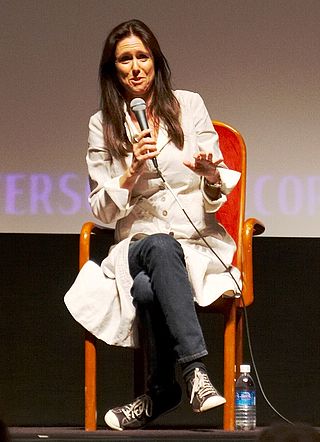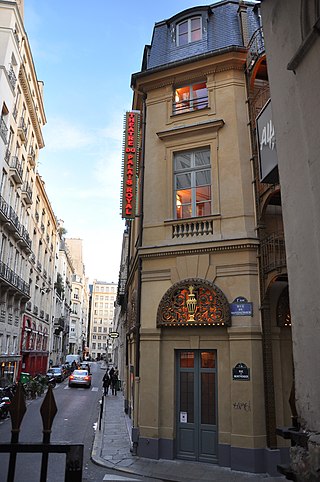Related Research Articles

The performing arts are arts such as music, dance, and drama which are performed for an audience. They are different from the visual arts, which involve the use of paint, canvas or various materials to create physical or static art objects. Performing arts include a range of disciplines which are performed in front of a live audience, including theatre, music, and dance.

Puppetry is a form of theatre or performance that involves the manipulation of puppets – inanimate objects, often resembling some type of human or animal figure, that are animated or manipulated by a human called a puppeteer. Such a performance is also known as a puppet production. The script for a puppet production is called a puppet play. Puppeteers use movements from hands and arms to control devices such as rods or strings to move the body, head, limbs, and in some cases the mouth and eyes of the puppet. The puppeteer sometimes speaks in the voice of the character of the puppet, while at other times they perform to a recorded soundtrack.

Julie Taymor is an American director and writer of theater, opera, and film. Her stage adaptation of The Lion King debuted in 1997 and received eleven Tony Award nominations, with Taymor receiving Tony Awards for her direction and costume design. Her 2002 film Frida, about Mexican artist Frida Kahlo, was nominated for five Academy Awards, including a Best Original Song nomination for Taymor's composition "Burn It Blue." She also directed the 2007 jukebox musical film Across the Universe, based on the music of the Beatles.

A marionette is a puppet controlled from above using wires or strings depending on regional variations. A marionette's puppeteer is called a marionettist. Marionettes are operated with the puppeteer hidden or revealed to an audience by using a vertical or horizontal control bar in different forms of theatres or entertainment venues. They have also been used in films and on television. The attachment of the strings varies according to its character or purpose.

Bunraku is a form of traditional Japanese puppet theatre, founded in Osaka in the beginning of the 17th century, which is still performed in the modern day. Three kinds of performers take part in a bunraku performance: the Ningyōtsukai or Ningyōzukai (puppeteers), the tayū (chanters), and shamisen musicians. Occasionally other instruments such as taiko drums will be used. The combination of chanting and shamisen playing is called jōruri and the Japanese word for puppet is ningyō. It is used in many plays.

Paul Finley Zaloom is an American actor and puppeteer, best known for his role as the character Beakman on the television show Beakman's World.

Russian ballet is a form of ballet characteristic of or originating from Russia.

Shadow play, also known as shadow puppetry, is an ancient form of storytelling and entertainment which uses flat articulated cut-out figures which are held between a source of light and a translucent screen or scrim. The cut-out shapes of the puppets sometimes include translucent color or other types of detailing. Various effects can be achieved by moving both the puppets and the light source. A talented puppeteer can make the figures appear to walk, dance, fight, nod and laugh.

Carnival is a musical, originally produced by David Merrick on Broadway in 1961, with the book by Michael Stewart and music and lyrics by Bob Merrill. The musical is based on the 1953 film Lili, which again was based on the short story and treatment titled "The Seven Souls of Clement O'Reilly" by Paul Gallico. The show's title originally used an exclamation point ; it was eventually dropped during the show's run, as director Gower Champion felt it gave the wrong impression, saying, "It's not a blockbuster. It's a gentle show."

The Center for Puppetry Arts, located in Atlanta, is the United States' largest organization dedicated to the art form of puppetry. The center focuses on three areas: performance, education and museum. It is one of the few puppet museums in the world. The center is located in Midtown, the city's arts district. It was founded in 1978 by Vincent Anthony.
Petrushka is a stock character of Russian folk puppetry. It was first introduced by traveling Italian performers in the first third of the 19th century during a period of Westernization in Russian culture. While most core characters came from Italy, they were soon transformed by the addition of material from the Russian cultural context.' Petrushkas are traditionally hand puppets. The character is a kind of a jester, a slapstick protagonist distinguished by his red dress, a red kolpak, and often a long nose.

Dadi Pudumjee is a leading puppeteer in India and he is the founder of The Ishara Puppet Theatre Trust. He was awarded the Sangeet Natak Akademi Award in 1992.
Sakorn Yang-keawsot was a Thai puppeteer. He was a master of the hun lakorn lek. Also known by his English nickname, Joe Louis, in 1965 he founded the Sakorn Hunlakornlek troupe with his daughter, Thitawan Yangkheiosod. Later, in 2001, his son, Pisutr Yang-keawsot formed a new troupe named Joe Louis and founded Joe Louis Puppet Theatre under his acknowledgment. He was named a National Artist for performing arts in 1996.

The Théâtre du Palais-Royal is a 750-seat Parisian theatre at 38 rue de Montpensier, located at the northwest corner of the Palais-Royal in the Galerie de Montpensier at its intersection with the Galerie de Beaujolais.

Basil Twist is a New York City-based puppeteer who is known for his underwater puppet show, "Symphonie Fantastique". He was named a MacArthur Fellowship recipient on September 29, 2015.

A puppet is an object, often resembling a human, animal or mythical figure, that is animated or manipulated by a person called a puppeteer. Puppetry is an ancient form of theatre which dates back to the 5th century BC in Ancient Greece.

The Handspring Puppet Company is a South African puppetry performance and design company. It was established in 1981 by Adrian Kohler, Basil Jones, Jon Weinberg, and Jill Joubert, and is based in Cape Town, South Africa.

Amelia Lirag Lapeña-Bonifacio was a Filipino playwright, puppeteer, and educator known as the "Grande Dame of Southeast Asian Children's Theatre". In 1977, she founded a children's theater troupe, Teatrong Mulat ng Pilipinas, the official theater company and puppetry troupe of the University of the Philippines. Lapeña-Bonifacio served as the President of the International Association of Theatre for Children and Young People-Philippines (ASSITEJ-Philippines) and Union Internationale de la Marionnette-Philippines (UNIMA-Philippines). She was recognized in 2018 as a National Artist of the Philippines for Theater.

Micheline Legendre was a Canadian puppeteer. She performed on television and on stage with her troupe, Les marionnettes de Montréal. Her oeuvre spanned 1,170 puppets created and more than 16,000 performances for 2.5 million audience members. Legendre was a violinist by training and her marionnette troupe played with the Montreal Symphony Orchestra and the New York Philharmonic, for Radio-Canada and the National Film Board of Canada, among others. She was also an art historian at the Université de Montréal.
Helen Haiman Joseph was an American puppeteer and author. Known as the "grandmother of American puppetry", she published plays, books, along with puppeteering nationally.
References
- 1 2 O'Connor, John J. "TV: Hand-Puppet Theater on Cable," Archived 24 May 2015 at the Wayback Machine The New York Times 7 July 1982.
- ↑ Wilson, Edmund. "Notes From a European Diary—1966 II—Rome," Archived 2 December 2020 at the Wayback Machine The New Yorker 21 May 1966. 74.
- 1 2 3 4 Berg, Paul. "Puppets For Adults," St. Louis Post-Dispatch 18 April 1965.
- ↑ Shepard, Richard F. "Puppet Theater Has 12-Year Run," Archived 4 February 2023 at the Wayback Machine The New York Times 4 May 1964.
- 1 2 3 Gross, Kenneth. "Love Translated: The Little Players," The Yale Review 94.1 2006.
- 1 2 "Mini Music Hall," Time 4 January 1971.
- ↑ White, Edmund. City Boy: My Life in New York During the 1960s and 1970s. London: Bloomsbury, 2009. 128.
- ↑ Hammer, Langdon. James Merrill: Life and Art. New York: Alfred A. Knopf, 2015. 491.
- ↑ "Guests," Archived 9 October 2020 at the Wayback Machine DickCavettShow.com. Accessed on 25 May 2020.
- ↑ Abrams, Steve. "In Memoriam: Francis Peschka 1921–1999." The Puppetry Journal 51.1 Fall 1999.
- ↑ "Nancy Staub Puppetry Research Library Tour Report | Georgia". connect.sla.org. Archived from the original on 25 June 2020. Retrieved 22 June 2020.